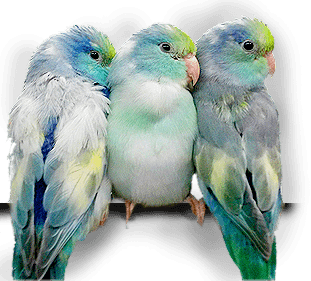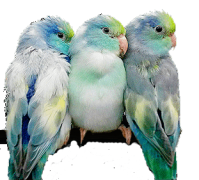Normal Feather Loss (Moulting)
The most common moult pattern is a full moult, including the wings and tail feathers, once a year and usually just prior to the breeding season. Partial moults also occur once a year. This ensures that birds do not lose too many feathers at one time that they are not rendered unable to fly. Losing large amounts of feathers revealing bare skin patches is considered abnormal and should be investigated.
Identifying Causes of Feather Loss
There are several causes of feather loss in birds. This first step toward treatment is to determine the cause of the feather loss. Obvious physical clues give us a direction to pursue, not a diagnosis. Birds have a limited number of signs to tell us they are sick. These few signs represent countless illnesses. Feather picking or feather loss in only one sign. It is up to your Veterinarian with diagnostic tools and the bird owner with information on environment and history to put all of these clues together to find the cause and determine the remedy.
Viral Disease
Polyomavirus and Psittacine (Beak and Feather disease) are serious diseases that may result in feather loss. Your Veterinarian can perform the appropriate test to determine if the causative agent is viral. Some Avian Veterinarians offer vaccines to prevent viral diseases affecting feather growth and loss in birds. Prevention is important, as once a birds contracts of these viruses and feather damage is evident, the disease is almost always fatal.
Parasites
Knemidokoptes (scaly face and scaly legs) is a skin parasite often seen in pet birds. Parakeets (Budgerigars and Canaries) are most often affected. It is first noticed as a thickening of the tissues on the face and legs. Even though the signs are visually apparent, the organism should be confirmed by microscopic examination before treatment is initiated. Remedies in pet stores can in some cases, create additional feather problems and longer periods of time to effect a cure. Appropriate prescription drugs work rapidly and effectively.
Red mites, Feather mites, or lice are also external parasites that infest birds causing skin irritation.
Feather problems are rarely the result of parasites but if parasites are suspected, your veterinarian should confirm the diagnosis and can recommend the proper treatment.
Giardia, a protozoan parasite has been implicated in some cases as self-mutilation. This intestinal parasite can be identified by microscopic examination of fresh droppings requiring that the sample be collected by your veterinarian in their office.
Bacterial and Fungal Disease
Staphylococcus or Pseudomonas are bacteria that may cause skin irritation resulting in feather loss due to self-mutilation. Your veterinarian can do a skin culture to identify these organisms.
Aspergillus or Candidiasis are fungal diseases that may cause skin irritation and require a dermatological workup including skin scrapings and cultures for identification.
Nutritional Causes
Dietary deficiencies can contribute to skin/feather disorders. Vitamin A deficiency has been implicated in nutritionally related feather disorders and an extreme lack of nutritional protein may affect the normal moult. Your veterinarian can advise you on modification of your bird’s current diet or supplementation of your bird’s diet to prevent or correct the potential problems.
Behavioral Causes
Self-mutilation (feather plucking or skin tearing) can have primary or secondary behavioral causes. Birds in the wild would have a mate or flock with to interact. Birds in captivity, human counterparts rarely fill the vacancy. Dominance factors, breeding, frustration, boredom, territoriality, mate-bonding, and nesting drives all triggered by hormonal development. These are rarely satisfied in a captive environment. The perception of threat from other household pets can initiate stress if the bird is constantly harassed. All of these factors can result in frustration grooming, which often becomes obsessive turning into a vice causing self-mutilation and feather damage or removal. Always supply your pet bird with plenty of toys and even rotating their toy inventory to prevent boredom. Foraging toys are excellent for relieving boredom.
Attack by Cagemates
If a cagemate is suspected to be the cause of feather loss the victim bird should be removed and separated for a minimum of six weeks to allow the feathers to regrow. If only part of a feather has been removed, it may not regrow until the next natural moult. If cagemate trauma is the cause, permanent separation may be the cure.
Other Possible Causes
External causes of skin irritation could be cage trauma, insect bites or stings, topical application of inappropriate ointments, or improper wing trimming. Outside factors such as chronic exposure to inhaled irritants such as cleaning products, tobacco, smoke from a barbecue, or toxic substrates. These can all lead to feather picking. Other household pet attacks such as dogs, cats or rodents may also result in feather loss.
Chronic diseases of the liver, kidneys, gastrointestinal tract, respiratory tract or atherosclerosis can manifest themselves as both stress related feather disorders or as self-mutilation. Feather cysts, tumors and injury are also possible stress related causes of feather loss.
Dirty Face Syndrome
If your bird suddenly seems to have a dirty face or broken or missing feathers around the beak and eyes, check to see if the bird can easily reach his food or water and that dishes are full. Birds trying to reach food remains dropped out of reach below cage floors develop dirty faces or broken face feathers from trying to push their heads through the wires of the cage. If empty food containers do not appear to be a problem, the dirty face may be caused by regurgitation or vomiting of food, you veterinarian should be contacted if this is the case.
Prevention
Protection from airborne toxins or irritants, aggressive cagemates, or other household pets is essential to the life and health of your pet bird. Birds tend to mask discomfort or illness making it difficult to determine their general well being. A thorough health examination by your veterinarian may reveal any internal diseases, parasites, or systemic diseases and these should be performed once a year.
Avoid
Sandpaper perches, Air pollutants such as cigarette smoke, insecticides, and toxic fumes from overheated non-stick cooking pans and utensils, mite boxes and mite sprays, easily dismantled toys such as balsa wood or small link chain items, toys with metal clips or skewers and toys with lead weights, toxic houseplants, ceiling fans, leaded glass or any lead items, cats, dogs, young children, and access to any cage substrate, fumes from hairspray. By avoiding these items you will ensure the safety and well being of your pet bird.


